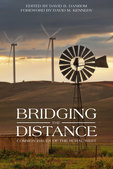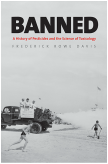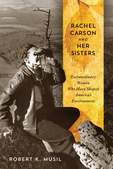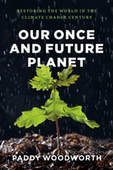Books

Vulnerable Harvests: Emergency Conservation in the Cold War Great Plains
(Under advanced contract with University of Nebraska Press).
Vulnerable Harvests examines the shifting roles of agricultural scientists, government policymakers, and producers during increasing ecological risks to the Great Plains West during the Cold War Era. The Great Plains Agricultural Council (GPAC) conducted numerous interdisciplinary experiments to protect harvests and preserve “industrial agriculture environments.” Ideas of emergency-based conservation through a series of climate, weather, soil, disease, drought, and pesticide studies conducted by the GPAC formalized cultivation practices, endorsed research, and reinforced market relationships that came to define Cold War era agriculture. The GPAC’s efforts to investigate climate changes, crop disease, chemical toxicity, and drought connected to earlier ideas about conservation of natural resources before the Silent Spring era, offering solutions to make Great Plains’ agricultural lands more protected and predictable for a “greater global good.”
This book will explore the environmental and agricultural history themes of risk, conservation, and emergency preparedness in the Great Plains during the decades of the Cold War. In this way, Vulnerable Harvests also helps us see how this region and its communities had much larger influence global food security policy.
(Under advanced contract with University of Nebraska Press).
Vulnerable Harvests examines the shifting roles of agricultural scientists, government policymakers, and producers during increasing ecological risks to the Great Plains West during the Cold War Era. The Great Plains Agricultural Council (GPAC) conducted numerous interdisciplinary experiments to protect harvests and preserve “industrial agriculture environments.” Ideas of emergency-based conservation through a series of climate, weather, soil, disease, drought, and pesticide studies conducted by the GPAC formalized cultivation practices, endorsed research, and reinforced market relationships that came to define Cold War era agriculture. The GPAC’s efforts to investigate climate changes, crop disease, chemical toxicity, and drought connected to earlier ideas about conservation of natural resources before the Silent Spring era, offering solutions to make Great Plains’ agricultural lands more protected and predictable for a “greater global good.”
This book will explore the environmental and agricultural history themes of risk, conservation, and emergency preparedness in the Great Plains during the decades of the Cold War. In this way, Vulnerable Harvests also helps us see how this region and its communities had much larger influence global food security policy.
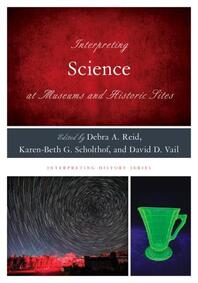
Interpreting Science at Museums and Historic Sites (Lanham, MD: Rowman & Littlefield, 2023)
(Coedited with Debra A. Reid and Karen-Beth Scholthof)
Interpreting Science in Museums and Historic Sites stresses the untapped potential of historical artifacts to inform our understanding of scientific topics. It argues that science gains ground when contextualized in museums and historic sites. Engaging audiences in conversations about topics such as health and medical sciences or climate change and responses to it, mediated by a history museum, can emphasize scientific rigor and the time lag between discovery and confirmation of societal benefit. Interpreting Science emphasizes the urgency of this work, provides a toolkit to start and sustain the work, shares case studies that model best practice, and resources useful to facilitate and sustain a science-infused public history.
(Coedited with Debra A. Reid and Karen-Beth Scholthof)
Interpreting Science in Museums and Historic Sites stresses the untapped potential of historical artifacts to inform our understanding of scientific topics. It argues that science gains ground when contextualized in museums and historic sites. Engaging audiences in conversations about topics such as health and medical sciences or climate change and responses to it, mediated by a history museum, can emphasize scientific rigor and the time lag between discovery and confirmation of societal benefit. Interpreting Science emphasizes the urgency of this work, provides a toolkit to start and sustain the work, shares case studies that model best practice, and resources useful to facilitate and sustain a science-infused public history.
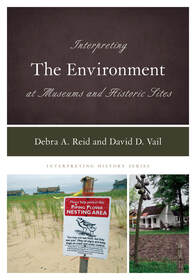
Interpreting the Environment at Museums and Historic Sites (Lanham, MD: Rowman & Littlefield, 2019)
(Coauthored with Debra A. Reid)
Interpreting the Environment at Museums and Historic Sites (coauthored with Debra A. Reid) is for anyone who wants to better understand the environment that surrounds us and sustains us, who wants to become a better steward of that environment, and who wants to share lessons learned with others. The process starts by focusing attention on the environment – the physical space that constitutes the largest three-dimensional object in museum collections. It involves conceptualizing spaces and places of human influence; spaces that contain layer upon layer documenting human struggles to survive and thrive. This evidence exists in natural environments as well as city centers. The process continues by adopting an environment-centric view of the spaces destined to be interpreted. This mind-set forms the basis for devising research plans that document how humans have changed, destroyed, conserved and sustained spaces over time, and the ways that the environment reacts. Interpretation built on this evidence then becomes the basis for minds-on engagement with the places that humans inhabit and the spaces that they have changed and continue to manipulate.
Interpreting the Environment at Museums and Historic Sites provides a tool kit designed to help you research environmental history, document evidence of human influence on land and the environment over time, and tailor that knowledge to new public engagement. It proposes a multi-disciplinary approach that requires expertise in the humanities as well as the sciences and social sciences to best understand space and place over time. It incorporates case studies of the theory and method of environmental history to explore how human goals take lasting shape in the environment – creating working environments, getting water, generating and harnessing power, growing food, traveling and trading, building things, and preserving natural landscapes.
Features include the Interpreting the Environment Tool Kit to help you launch the good work of interpreting the environment:
(Coauthored with Debra A. Reid)
Interpreting the Environment at Museums and Historic Sites (coauthored with Debra A. Reid) is for anyone who wants to better understand the environment that surrounds us and sustains us, who wants to become a better steward of that environment, and who wants to share lessons learned with others. The process starts by focusing attention on the environment – the physical space that constitutes the largest three-dimensional object in museum collections. It involves conceptualizing spaces and places of human influence; spaces that contain layer upon layer documenting human struggles to survive and thrive. This evidence exists in natural environments as well as city centers. The process continues by adopting an environment-centric view of the spaces destined to be interpreted. This mind-set forms the basis for devising research plans that document how humans have changed, destroyed, conserved and sustained spaces over time, and the ways that the environment reacts. Interpretation built on this evidence then becomes the basis for minds-on engagement with the places that humans inhabit and the spaces that they have changed and continue to manipulate.
Interpreting the Environment at Museums and Historic Sites provides a tool kit designed to help you research environmental history, document evidence of human influence on land and the environment over time, and tailor that knowledge to new public engagement. It proposes a multi-disciplinary approach that requires expertise in the humanities as well as the sciences and social sciences to best understand space and place over time. It incorporates case studies of the theory and method of environmental history to explore how human goals take lasting shape in the environment – creating working environments, getting water, generating and harnessing power, growing food, traveling and trading, building things, and preserving natural landscapes.
Features include the Interpreting the Environment Tool Kit to help you launch the good work of interpreting the environment:
- Raw Materials (the evidence): landscape, ecosystems, artifacts, and the built environment
- Preparation (methods): thinking like a naturalist/scientist; thinking like a historian; combining approaches
- Planning (envisioning the goal): proactive message, stewardship, sustainability
- Partnerships (sharing work): strength in numbers; allying across disciplinary divides; united in efforts to inform the public about their individual and collective effects on the landscape and the environment
- Potential: educating the public about people and places is part of a world-wide goal with the cumulative effect of saving the planet, one story at a time.
- A Timeline and Bibliographic essay round out the book’s resources.
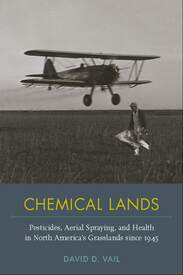
Chemical Lands: Pesticides, Aerial Spraying, and Health in North America's Grasslands since 1945 (Tuscaloosa: University of Alabama Press, 2018)
The controversies in the 1960s and 1970s that swirled around indiscriminate use of agricultural chemicals—their long-term ecological harm versus food production benefits—were sparked and clarified by biologist Rachel Carson’s Silent Spring (1962). This seminal publication challenged long-held assumptions concerning the industrial might of American agriculture while sounding an alarm for the damaging persistence of pesticides, especially chlorinated hydrocarbons such as DDT, in the larger environment.
In Chemical Lands: Pesticides, Aerial Spraying, and Health in North America’s Grasslands since 1945, David D. Vail shows, however, that a distinctly regional view of agricultural health evolved. His analysis reveals a particularly strong ethic in the North American grasslands where practitioners sought to understand and deploy insecticides and herbicides by designing local scientific experiments, engineering more precise aircraft sprayers, developing more narrowly specific chemicals, and planting targeted test crops. Their efforts to link the science of toxicology with environmental health reveal how the practitioners of pesticides evaluated potential hazards in the agricultural landscape while recognizing the production benefits of controlled spraying.
Chemical Lands adds to a growing list of books on toxins in the American landscape. This study provides a unique Grasslands perspective of the Ag pilots, weed scientists, and farmers who struggled to navigate novel technologies for spray planes and in the development of new herbicides/insecticides while striving to manage and mitigate threats to human health and the environment.
Awards/Honors:
Reviews:
The controversies in the 1960s and 1970s that swirled around indiscriminate use of agricultural chemicals—their long-term ecological harm versus food production benefits—were sparked and clarified by biologist Rachel Carson’s Silent Spring (1962). This seminal publication challenged long-held assumptions concerning the industrial might of American agriculture while sounding an alarm for the damaging persistence of pesticides, especially chlorinated hydrocarbons such as DDT, in the larger environment.
In Chemical Lands: Pesticides, Aerial Spraying, and Health in North America’s Grasslands since 1945, David D. Vail shows, however, that a distinctly regional view of agricultural health evolved. His analysis reveals a particularly strong ethic in the North American grasslands where practitioners sought to understand and deploy insecticides and herbicides by designing local scientific experiments, engineering more precise aircraft sprayers, developing more narrowly specific chemicals, and planting targeted test crops. Their efforts to link the science of toxicology with environmental health reveal how the practitioners of pesticides evaluated potential hazards in the agricultural landscape while recognizing the production benefits of controlled spraying.
Chemical Lands adds to a growing list of books on toxins in the American landscape. This study provides a unique Grasslands perspective of the Ag pilots, weed scientists, and farmers who struggled to navigate novel technologies for spray planes and in the development of new herbicides/insecticides while striving to manage and mitigate threats to human health and the environment.
Awards/Honors:
- "Bookshelf" selection by Phi Kappa Phi Forum Magazine, Summer 2018
- University of Nebraska's Center for Great Plains Studies "Book of the Month" selection for June 2018
Reviews:
- "The story Vail tells is fascinating and important. Chemical Lands makes a valuable contribution to a growing field of pesticide history, which is a a body of literature that examines the complicated relationship between chemicals, humans, and nature. Vail's history of spray pilots cuts across multiple strands of this literature, while effectively building on it."
--American Historical Review
- "Chemical Lands is a valuable reminder that the embrace of pesticides after World War II was complex and shaped by a variety of factors including the perceived threats of insect and plant pests, the adaption of technologies to particular circumstances, and an ongoing debate about both the risks and benefits of the chemicals."
--Journal of American History
- "Vail has written a smart, polished, and valuable book of interest to environmental historians and historians of technology as well as agricultural historians. Vail tells the story of aerial spraying as the complex tale that it is, with careful attention to regional distinctiveness, the creation of expertise, the assessment of risk, and the role of technology. But he tells it with clarity and energy, showing how much we can learn with careful attention to the practices and protocols of pesticide use."
- "Chemical Lands adds an important perspective to recently published work critically reexamining the history of pesticides, toxicology, contamination, and Silent Spring. This well-written and expertly researched book joins a growing chorus of scholars across history, science technology and society, anthropology, and geography who are asking that we rethink the forces that produced, and continue to produce, our contaminated world."
- "Vail's regional synthesis of themes agricultural, technological, social, and environmental makes [Chemical Lands] a welcome addition to histories of the Great Plains and environmental toxicity."
- "Chemical Lands is a fine addition to environmental historiography, and scholars studying agricultural history will find it to be a useful book."
- "The 20th century has seen several shifts in agricultural practices, but none have had a more profound effect than the use of pesticides. The agriculture industry in the American Great Plains forms the core of its economy; as pressures to moderate insect and weed threats increased, this region was acutely impacted by the need to develop pesticides and improve methods for their efficient application over large swaths of land. In Chemical Lands, Vail traces the philosophy of pesticide use and the efforts by universities, applicators, and chemical companies to improve pesticide safety. This text focuses chiefly on the evolution of aerial pesticide application technology . . . Overall, readers gain a nuanced perspective on the utility of pesticides alongside the vital importance of developing methods to ensure the health of the environment. Recommended."
Book Chapters
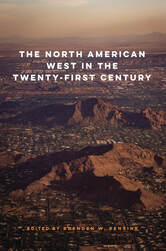
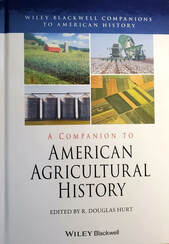
Recent Articles
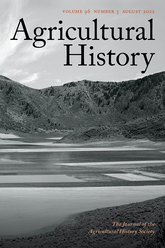
“False Gospels of Efficiency: Contested Knowledge, Determined Experts, and Unfaithful Lands in Rural Utah,” Agricultural History 96.3 (August 2022): 342–378.
This article examines the conflicts over knowledge, expertise, spiritual promises, and agroecological realities that collided in the construction of an early-1900s rural water conservation district in Cache Valley, Utah. Out of these tensions emerged a field-based view of conservation that oscillated between hydrologists’ teachings of rational management through irrigation and local dry farming practices that seemed to acknowledge the valley’s limitations—all in a futile effort to make the land faithful to an agri-spiritual aesthetic that persuaded scientists and farmers alike to rebuild District No. 1 over and over again. From debates about whose expertise to follow to economic devastation from illicit dealings of dubious financiers and unruly environmental conditions, the saga of Cache County Water Conservation
District No. 1 reveals an irrigated rural western landscape that was as unpredictable as it was inescapable.
This article examines the conflicts over knowledge, expertise, spiritual promises, and agroecological realities that collided in the construction of an early-1900s rural water conservation district in Cache Valley, Utah. Out of these tensions emerged a field-based view of conservation that oscillated between hydrologists’ teachings of rational management through irrigation and local dry farming practices that seemed to acknowledge the valley’s limitations—all in a futile effort to make the land faithful to an agri-spiritual aesthetic that persuaded scientists and farmers alike to rebuild District No. 1 over and over again. From debates about whose expertise to follow to economic devastation from illicit dealings of dubious financiers and unruly environmental conditions, the saga of Cache County Water Conservation
District No. 1 reveals an irrigated rural western landscape that was as unpredictable as it was inescapable.
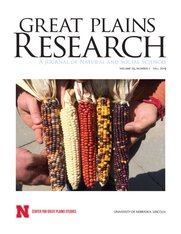
"Field Notes: Exploring the STEM-Humanities History of Nebraska's Agriculture: Expanded Remarks for the 2018 Warner Lecture," Great Plains Research 29 (Fall 2019): 55–69.
This article is an expansion of my Warner Lecture for the College of Arts and Sciences at the University of Nebraska Kearney (UNK) in 2018. The university lecture series is named for the two dedicated Nebraska state senators, Charles Warner and Jerome Warner. Both embraced the ideas of bipartisanship and collective civic good for Nebraska residents. Beyond the connections to my research interests in environmental history, agricultural history, science and technology, and the Great Plains, my remarks offered historical examples in Nebraska agriculture to inspire audience members to think in interdisciplinary terms, across their specialties and professional training, to address important issues facing the state. "Field Notes" also provided historical perspectives around integrated learning models between the STEM fields (science, technology, engineering, and math) and the humanities as two colleges at UNK, the Natural and Social Sciences and the Fine Arts and Humanities, merged into the College of Arts and Sciences in the 2018–19 school year.
This article is an expansion of my Warner Lecture for the College of Arts and Sciences at the University of Nebraska Kearney (UNK) in 2018. The university lecture series is named for the two dedicated Nebraska state senators, Charles Warner and Jerome Warner. Both embraced the ideas of bipartisanship and collective civic good for Nebraska residents. Beyond the connections to my research interests in environmental history, agricultural history, science and technology, and the Great Plains, my remarks offered historical examples in Nebraska agriculture to inspire audience members to think in interdisciplinary terms, across their specialties and professional training, to address important issues facing the state. "Field Notes" also provided historical perspectives around integrated learning models between the STEM fields (science, technology, engineering, and math) and the humanities as two colleges at UNK, the Natural and Social Sciences and the Fine Arts and Humanities, merged into the College of Arts and Sciences in the 2018–19 school year.
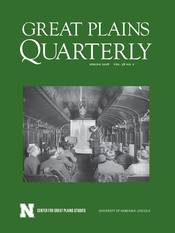
“Farming by Rail: Demonstration Trains and the Rise of Mobile Agricultural Science in the Great Plains,” Great Plains Quarterly 38 (Spring 2018): 151–174.
In the early 1900s, railroad companies throughout the Great Plains worked with agricultural extension personnel and land-grant colleges to design demonstration trains for rural communities. Historian David Vail examines how these “farming specials” connected field and extension science by designing mobile laboratories that traveled from town to town to promote the newest farming technologies as well as to assist landowners with threats to their fields. This article considers the intersections of science, technology, environment, and production farming to better understand how specialized agricultural science connected to experiential practices on the land.
In the early 1900s, railroad companies throughout the Great Plains worked with agricultural extension personnel and land-grant colleges to design demonstration trains for rural communities. Historian David Vail examines how these “farming specials” connected field and extension science by designing mobile laboratories that traveled from town to town to promote the newest farming technologies as well as to assist landowners with threats to their fields. This article considers the intersections of science, technology, environment, and production farming to better understand how specialized agricultural science connected to experiential practices on the land.
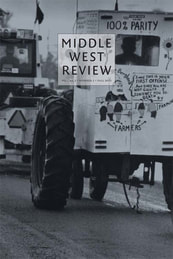
"Sustaining the Conversation: The Farm Crisis and the Midwest," Introduction to Special Issue with Jenny Barker Devine. Middle West Review: An Interdisciplinary Journal about the American Midwest 2 (Fall 2015): 1-10.
This special issue of Middle West Review explores the history of America's farm crisis throughout the 1980s. Jenny Barker Devine and David D. Vail introduce how the complexities inherent to American agriculture contributed to a devastating series of economic failures. As both authors argue, the crisis did not have a singular cause but "emerged through a product of changing social and technological circumstances in the countryside, devastating droughts, increasing levels of farm debt and decades of complex, sometimes contradictory, federal policies." The special issue includes articles and essays from historians, activists, and archivists that survey this recent past as well as forge new pathways for future scholars.
This special issue of Middle West Review explores the history of America's farm crisis throughout the 1980s. Jenny Barker Devine and David D. Vail introduce how the complexities inherent to American agriculture contributed to a devastating series of economic failures. As both authors argue, the crisis did not have a singular cause but "emerged through a product of changing social and technological circumstances in the countryside, devastating droughts, increasing levels of farm debt and decades of complex, sometimes contradictory, federal policies." The special issue includes articles and essays from historians, activists, and archivists that survey this recent past as well as forge new pathways for future scholars.
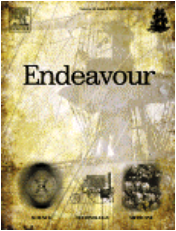
"Toxic Fables: The Advertising and Marketing of Agricultural Chemicals in the Great Plains, 1945-1985." Endeavour 36 (December 2012): 165-173.
This article examines how pesticides and their technologies were sold to farmers and pilots throughout the mid-twentieth century. It principally considers how marketing rhetoric and advertisement strategies used by chemical companies and aerial spraying firms influenced the practices and perspectives of farm producers in the Great Plains. In order to convince landowners and agricultural leaders to buy their pesticides, chemical companies generated advertisements that championed local crop health, mixture accuracy, livestock safety and a chemical-farming ‘way of life’ that kept fields healthy and productive. Combining notions of safety, accuracy and professionalism with pest eradication messages reinforced the standards that landowners, pilots and agriculturalists would hold regarding toxicity and risk when spraying their fields. As the politics of health changed in the aftermath of Rachel Carson's Silent Spring, these companies and aerial spraying outfits responded by keeping to a vision of agricultural health that required poisons for protection through technological accuracy.
This article examines how pesticides and their technologies were sold to farmers and pilots throughout the mid-twentieth century. It principally considers how marketing rhetoric and advertisement strategies used by chemical companies and aerial spraying firms influenced the practices and perspectives of farm producers in the Great Plains. In order to convince landowners and agricultural leaders to buy their pesticides, chemical companies generated advertisements that championed local crop health, mixture accuracy, livestock safety and a chemical-farming ‘way of life’ that kept fields healthy and productive. Combining notions of safety, accuracy and professionalism with pest eradication messages reinforced the standards that landowners, pilots and agriculturalists would hold regarding toxicity and risk when spraying their fields. As the politics of health changed in the aftermath of Rachel Carson's Silent Spring, these companies and aerial spraying outfits responded by keeping to a vision of agricultural health that required poisons for protection through technological accuracy.
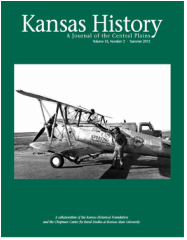
"Kill That Thistle: Rogue Sprayers, Bootlegged Chemicals, Wicked Weeds, and the Kansas Chemical Laws, 1945-1980." Kansas History: A Journal of the Great Plains 35 (Summer 2012): 116-133.
Scholars have largely assessed America’s chemical history by focusing on the regulations and politics of pesticides. Many of these works focused on the post-World War II debates over DDT, the social activism that Rachel Carson inspired with her 1962 book Silent Spring, and the growing oversight of the Environmental Protection Agency in the 1970s. Historian David Vail, however, provides an alternate story by examining how farmers, agricultural pilots, and Kansas experts constructed a chemical-risk standard much earlier in the postwar era that attempted to balance economic goals with the health of their fields and communities. Part of this standard focused on chemical toxicity while another part addressed a nonhuman form of “poisonous injury” that came from pests, primarily weeds. A third vector of contamination came from rogue sprayers and chemical bootleggers. In addition to Dr. Vail’s examination of the agricultural, technological, and environmental changes that pesticides, pests, and producers brought to mid-twentieth-century Kansas farming, he also provides new insights into the long overlooked history of aerial application and the state’s contribution to that industry’s postwar evolution.
Scholars have largely assessed America’s chemical history by focusing on the regulations and politics of pesticides. Many of these works focused on the post-World War II debates over DDT, the social activism that Rachel Carson inspired with her 1962 book Silent Spring, and the growing oversight of the Environmental Protection Agency in the 1970s. Historian David Vail, however, provides an alternate story by examining how farmers, agricultural pilots, and Kansas experts constructed a chemical-risk standard much earlier in the postwar era that attempted to balance economic goals with the health of their fields and communities. Part of this standard focused on chemical toxicity while another part addressed a nonhuman form of “poisonous injury” that came from pests, primarily weeds. A third vector of contamination came from rogue sprayers and chemical bootleggers. In addition to Dr. Vail’s examination of the agricultural, technological, and environmental changes that pesticides, pests, and producers brought to mid-twentieth-century Kansas farming, he also provides new insights into the long overlooked history of aerial application and the state’s contribution to that industry’s postwar evolution.
Review Essays
|
“Has the Frontier Won?: Unsettlement versus Resurgence in the Rural West,” including Bridging the Distance: Common Issues of the Rural West by David B. Danbom eds; The Small-Town Midwest: Resilience and Hope in the Twenty-First Century by Julianne Couch. Nebraska History 97 (Winter 2016): 215–216.
“Toxicity Abounds: New Histories on Pesticides, Environmentalism, and Silent Spring,” including Banned: A History of Pesticides and the Science of Toxicology, by Frederick Davis; Our Once and Future Planet by Paddy Woodworth; Rachel Carson and Her Sisters by Robert Musil. Studies in History and Philosophy of Science Part C: Studies in History and Philosophy of Biological and Biomedical Sciences 53 (October 2015): 118-121.
|
Recent Book Reviews
Framing the Farm Bill: Interests, Ideology, and the Agricultural Act of 2014, by Christopher Bosso. H-
FedHist–Humanities and Social Sciences Online (April 2022): 1–3.
Guadalupe Mountains National Park: An Environmental History of the Southwest Borderlands, by Jeffrey P. Shepherd. Journal of American History (March 2022): 803–804.
Field Life: Science in the American West during the Railroad Era, by Jeremy Vetter. Journal of American History 106 (December 2019): 784–785.
A History of Occupational Health and Safety: From 1905 to the Present, by Michelle Follette Turk. Western Historical Quarterly (Winter 2019): 432–433.
Looking Forward: Prediction and Uncertainty in Modern America, by Jamie L. Pietruska. Environmental History 24 (April 2019): 419–420.
The Lost Species: Great Expeditions in the Collections of Natural History Museums by Christopher Kemp. The Public Historian 41 (February 2019): 179–181.
Listening in the Field: Recording and the Science of Birdsong by Joeri Bruyninckx. Human-Wildlife Interactions 12 (Fall 2018): 291–292.
Bison and People on the North American Great Plains: A Deep Environmental History edited by Geoff Cunfer and Bill Waiser. Environmental History 23 (January 2018): 201–202.
Coyote America: A Natural and Supernatural History by Dan Flores. Human-Wildlife Interactions 11 (Fall 2017): 233–234.
Prelude to the Dust Bowl: Drought in the Nineteenth-Century Southern Plains by Kevin Z. Sweeney.
Journal of Interdisciplinary History 48 (Summer 2017), 99–100.
A Land Made from Water: Appropriation and the Evolution of Colorado’s Landscape, Ditches, and Water
Institutions by Robert R. Crifasi. Western Historical Quarterly 3 (Winter 2016), 1–2.
The Blue and the Green: A Cultural Ecological History of an Arizona Ranching Community by Jack
Stauder. H-Environment–Humanities and Social Sciences Online (September 2016): 1–2.
Arresting Contagion: Science, Policy, and Conflicts over Animal Disease Control by Alan L. Olmstead and Paul W. Rhode. Human-Wildlife Interactions 9 (Fall 2015): 277-278.
Arming Mother Nature: The Birth of Catastrophic Environmentalism by Jacob Darwin Hamblin. Kansas History 37.1 (Spring 2014): 55.
“DDT Diplomacy: Pesticides, Public Health, and Foreign Policy in the Chemical Age.” Review of DDT and the American Century by David Kinkela. H-Environment–Humanities and Social Sciences Online (May 2012).
FedHist–Humanities and Social Sciences Online (April 2022): 1–3.
Guadalupe Mountains National Park: An Environmental History of the Southwest Borderlands, by Jeffrey P. Shepherd. Journal of American History (March 2022): 803–804.
Field Life: Science in the American West during the Railroad Era, by Jeremy Vetter. Journal of American History 106 (December 2019): 784–785.
A History of Occupational Health and Safety: From 1905 to the Present, by Michelle Follette Turk. Western Historical Quarterly (Winter 2019): 432–433.
Looking Forward: Prediction and Uncertainty in Modern America, by Jamie L. Pietruska. Environmental History 24 (April 2019): 419–420.
The Lost Species: Great Expeditions in the Collections of Natural History Museums by Christopher Kemp. The Public Historian 41 (February 2019): 179–181.
Listening in the Field: Recording and the Science of Birdsong by Joeri Bruyninckx. Human-Wildlife Interactions 12 (Fall 2018): 291–292.
Bison and People on the North American Great Plains: A Deep Environmental History edited by Geoff Cunfer and Bill Waiser. Environmental History 23 (January 2018): 201–202.
Coyote America: A Natural and Supernatural History by Dan Flores. Human-Wildlife Interactions 11 (Fall 2017): 233–234.
Prelude to the Dust Bowl: Drought in the Nineteenth-Century Southern Plains by Kevin Z. Sweeney.
Journal of Interdisciplinary History 48 (Summer 2017), 99–100.
A Land Made from Water: Appropriation and the Evolution of Colorado’s Landscape, Ditches, and Water
Institutions by Robert R. Crifasi. Western Historical Quarterly 3 (Winter 2016), 1–2.
The Blue and the Green: A Cultural Ecological History of an Arizona Ranching Community by Jack
Stauder. H-Environment–Humanities and Social Sciences Online (September 2016): 1–2.
Arresting Contagion: Science, Policy, and Conflicts over Animal Disease Control by Alan L. Olmstead and Paul W. Rhode. Human-Wildlife Interactions 9 (Fall 2015): 277-278.
Arming Mother Nature: The Birth of Catastrophic Environmentalism by Jacob Darwin Hamblin. Kansas History 37.1 (Spring 2014): 55.
“DDT Diplomacy: Pesticides, Public Health, and Foreign Policy in the Chemical Age.” Review of DDT and the American Century by David Kinkela. H-Environment–Humanities and Social Sciences Online (May 2012).
